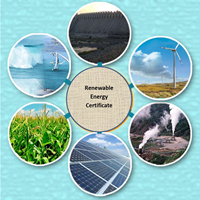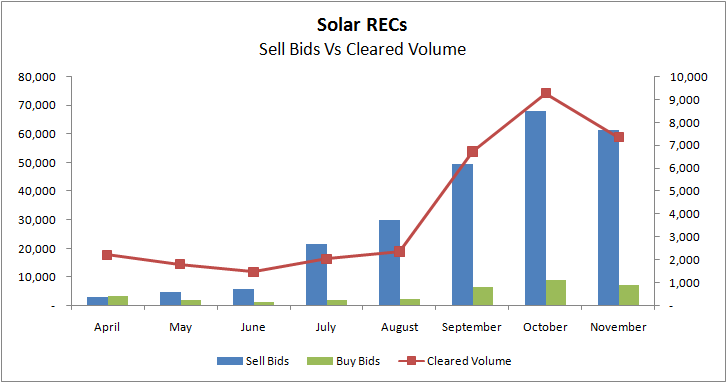
Non-Solar REC Segment
| ||||
Parameter
|
IEX
|
PXI
|
Total
|
Trend
|
Buy Bids
|
97,743
|
2,11,185
|
3,08,928
|
105%
|
Sell Bids
|
27,60,452
|
13,79,113
|
41,39,565
|
7%
|
Cleared Volume
|
97,743
|
2,11,185
|
3,08,928
|
105%
|
Cleared Price
|
1,500
|
1,500
|
1,500
|
0%
|
Cleared Volume as % of Total Sell Bids
|
7.46%
| |||
Transaction Amount (Rs. Crs)
|
46.34
| |||
- The Cleared Volume of Non-Solar RECs have been increased by more than 105%
- However, the above was mainly on account of the observed increased of more than 308% on PXI; on IEX a marginal decrease of 1% was observed.
- The Clearance Ratio in terms of Perc over Sell Bids has been increased to 7.45% from 3.88% in the previous month.
- The Market Clearing Price observed was the Floor Price i.e Rs. 1500 per RECs.
- Below charts shall give more clarity this.


Analysis of Solar REC Segment
Solar REC Segment
| ||||
Parameter
|
IEX
|
PXI
|
Total
|
Trend
|
Buy Bids
|
6,983
|
371
|
7,354
|
-21%
|
Sell Bids
|
45,819
|
15,538
|
61,357
|
-10%
|
Cleared Volume
|
6,983
|
371
|
7,354
|
-21%
|
Cleared Price
|
9,300
|
9,300
|
9,300
|
0%
|
Cleared Volume as % of Total Sell Bids
|
11.99%
| |||
Transaction Amount (Rs. Crs)
|
6.84
| |||
- The Cleared Volume of Solar RECs have been decreased by around 21%.
- However, the above was mainly on account of the observed decrease of more than 86% on PXI; on IEX, increase of 6.6% was observed.
- The Clearance Ratio in terms of Perc over Sell Bids has been decreased to 12% from 13.6% in the previous month.
- The Market Clearing Price observed was the Floor Price i.e Rs. 9300 per RECs.
- Below charts shall give more clarity this.


Excel (xls) file for the complete data on RECs (Both Solar & Non Solar) for the current financial year can be downloaded from this link.
Source: IEX and PXI












 What could be the financial cost to the nation of the loss of output from captive coal mines allocated to corporates over the past decade? The cost is a whopping Rs 1.46 lakh crore -- a result of delayed clearances for coal blocks and the companies’ own failure in developing the mines.
What could be the financial cost to the nation of the loss of output from captive coal mines allocated to corporates over the past decade? The cost is a whopping Rs 1.46 lakh crore -- a result of delayed clearances for coal blocks and the companies’ own failure in developing the mines.